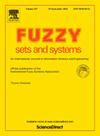正凸模糊真值上2型t模之间的关系
IF 2.7
1区 数学
Q2 COMPUTER SCIENCE, THEORY & METHODS
引用次数: 0
摘要
最近的文献主要集中在由所有正凸模糊真值组成的FNC上的四种形式的2型t-范数:完全格上定义的t-范数,Hernández等定义的tr-范数,Harding等定义的tl -范数,Wu等定义的tl -范数。本文研究了由Zadeh的可拓原理推广而来的广义扩展t模构造的这四类2型t模之间的关系。首先,我们依次刻画了广义扩展t模满足2型t模定义中各限制公理的条件,特别是闭包性质。然后,我们证明了在FNC上,广义扩展t-范数是t-范数。t0 -范数等价于它们是tr-范数(例如。tlor-norms)。最后,通过实例证明了在FNC上,低范数(p < 0.05)。t-范数)严格地强于t-范数(如。t-范数)即使它们都是由广义扩展t-范数构造的。本文章由计算机程序翻译,如有差异,请以英文原文为准。
The relationships between type-2 t-norms on normal convex fuzzy truth values
Recent literature has mainly focused on four forms of type-2 t-norms on composed of all normal convex fuzzy truth values: t-norms defined on the complete lattice, tr-norms defined by Hernández et al., t-norms defined by Harding et al., and t-norms defined by Wu et al. The paper studies the relationships among these four types of type-2 t-norms constructed by generalized extended t-norms that come from the generalization of Zadeh's extension principle. Firstly, we sequentially characterize the conditions under which generalized extended t-norms satisfy each restrictive axiom in the definitions of type-2 t-norms, particularly closure properties. Then, we prove that on , generalized extended t-norms being t-norms (resp. t-norms) is equivalent to them being tr-norms (resp. t-norms). Finally, through examples, we demonstrate that on , t-norms (resp. t-norms) are strictly stronger than t-norms (resp. tr-norms) even if all of them are constructed by generalized extended t-norms.
求助全文
通过发布文献求助,成功后即可免费获取论文全文。
去求助
来源期刊

Fuzzy Sets and Systems
数学-计算机:理论方法
CiteScore
6.50
自引率
17.90%
发文量
321
审稿时长
6.1 months
期刊介绍:
Since its launching in 1978, the journal Fuzzy Sets and Systems has been devoted to the international advancement of the theory and application of fuzzy sets and systems. The theory of fuzzy sets now encompasses a well organized corpus of basic notions including (and not restricted to) aggregation operations, a generalized theory of relations, specific measures of information content, a calculus of fuzzy numbers. Fuzzy sets are also the cornerstone of a non-additive uncertainty theory, namely possibility theory, and of a versatile tool for both linguistic and numerical modeling: fuzzy rule-based systems. Numerous works now combine fuzzy concepts with other scientific disciplines as well as modern technologies.
In mathematics fuzzy sets have triggered new research topics in connection with category theory, topology, algebra, analysis. Fuzzy sets are also part of a recent trend in the study of generalized measures and integrals, and are combined with statistical methods. Furthermore, fuzzy sets have strong logical underpinnings in the tradition of many-valued logics.
 求助内容:
求助内容: 应助结果提醒方式:
应助结果提醒方式:


